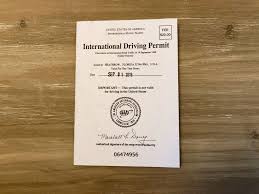Introduction
Having a valid driver’s license is an essential part of everyday life for many individuals. Whether you rely on your vehicle for commuting to work, running errands, or traveling, a driver’s license is often the key to freedom and convenience. However, there are instances when a driver’s license can be suspended, which may prevent individuals from driving legally. Additionally, individuals moving or traveling internationally may need to exchange their foreign driver’s licenses for a local one. In this article, we will explore the process of renewing a suspended driver’s license and exchanging an international renew suspended driver’s license. Understanding these processes is important for individuals seeking to regain their driving privileges or adapt to new driving environments.
Reasons Why a Driver’s License May Be Suspended
A suspended driver’s license can result from a variety of reasons, including but not limited to, accumulating too many traffic violations, failing to pay fines, driving under the influence of alcohol or drugs, or being involved in serious accidents. Each country or region has its own set of rules and regulations governing the suspension of licenses, but the consequences are generally similar. For example, a driver’s license may be suspended temporarily, meaning the individual can regain their driving privileges after meeting certain requirements. In some cases, however, the suspension may be permanent, which can have serious consequences on an individual’s ability to work and travel.
The length of a suspension can vary depending on the severity of the offense, and it is often determined by local authorities or the court. During this period, individuals are usually not allowed to drive legally, and engaging in driving activities while their license is suspended can result in additional penalties, including fines or even jail time. If your license has been suspended, it’s crucial to understand the specific reasons for the suspension and the steps required to have it reinstated.
Steps to Renew a Suspended Driver’s License
Renewing a suspended driver’s license may seem like a daunting task, but it is usually possible if you follow the correct steps. The first thing you should do is determine the specific reasons why exchange an international driver’s license was suspended. This information can typically be obtained by contacting your local Department of Motor Vehicles (DMV) or the relevant licensing authority in your area. Some common reasons for suspension may include traffic violations, failure to attend a driving course, or failure to pay traffic fines.
Once you know the reason for your suspension, you can start working towards meeting the requirements for reinstatement. For instance, if your license was suspended due to unpaid fines, you may need to settle these debts before your driving privileges can be restored. If your suspension was due to a driving under the influence (DUI) offense, you may be required to complete a rehabilitation program or attend court-mandated classes. After fulfilling the necessary requirements, you can typically apply for license reinstatement online or by visiting a local licensing office.
In many cases, the DMV will charge a reinstatement fee, which varies depending on the severity of the offense and the region in which you live. Once all requirements are met and the reinstatement fee is paid, your driver’s license may be renewed, allowing you to legally drive once again.
How to Appeal a Suspended Driver’s License
In some cases, individuals may feel that their driver’s license suspension was unjust or that the penalties imposed were too harsh. If this is the case, it is possible to appeal the suspension through a legal process. The specific procedures for appealing a suspended license will depend on the local laws in your area.
Generally, to appeal a suspension, you will need to file a formal request with the relevant licensing authority or the court. It is helpful to provide any supporting evidence that may help your case, such as proof of completed driving courses or documents showing that fines have been paid. It is also beneficial to consult with a legal professional, especially if your suspension is related to serious offenses such as DUI. A lawyer specializing in traffic law can guide you through the appeals process and improve your chances of having the suspension overturned or reduced.
Appealing a suspended driver’s license can be a lengthy process, and the outcome is not always guaranteed. However, if you believe that your suspension was unfair or that you have fulfilled all necessary requirements for reinstatement, it may be worth pursuing an appeal.
What to Do If Your License Is Permanently Suspended
In some unfortunate cases, a driver’s license may be permanently suspended, particularly if the individual has committed multiple severe offenses. A permanent suspension means that the individual is no longer eligible to hold a driver’s license under any circumstances. If your license has been permanently suspended, it may be very difficult to regain your driving privileges.
If you find yourself in this situation, you may want to explore alternatives such as applying for a restricted or provisional license. In some cases, local authorities may allow individuals to apply for a restricted license that permits limited driving under certain conditions, such as driving only for work or medical purposes. This process may involve submitting a petition or attending a hearing to demonstrate why you should be allowed to drive despite the permanent suspension.
It is important to note that permanent suspensions are typically issued after multiple violations, such as repeated DUIs or serious accidents, so if your license has been permanently revoked, it is essential to carefully follow all legal procedures and work with legal counsel to determine any options available to you.
Exchanging an International Driver’s License
For individuals who move abroad or plan to drive in another country, exchanging an international driver’s license for a local one may be necessary. Many countries require foreign drivers to exchange their international driving permits or foreign-issued licenses for a local equivalent. The process for exchanging an international driver’s license depends on the country in which you are residing or visiting and the agreements in place between your home country and the host country.
In some countries, such as those within the European Union, citizens of member states can usually exchange their international driver’s licenses for a local license without taking additional tests. This is often a straightforward process that requires presenting proof of identity, residency, and a valid international driving permit. However, other countries may require you to take a written exam or practical driving test to ensure that you are familiar with local driving laws and road conditions.
To exchange an international driver’s license, you will typically need to contact the local licensing authority or Department of Motor Vehicles (DMV) in your area. They will provide detailed instructions on the necessary documents and steps required to complete the exchange. Some countries may also charge a fee for exchanging your license, and you may need to surrender your international license as part of the process.
Documents Required for Exchanging an International Driver’s License
The exact documents required for exchanging an international driver’s license will vary depending on the country and local regulations. However, common requirements typically include:
A valid passport or national ID card
Proof of residency in the country where you are applying for the exchange
Your international driver’s license or foreign-issued driving permit
A recent passport-sized photo
Proof of address (e.g., utility bills or rental agreements)
Any fees associated with the exchange process
In some cases, you may also be required to provide a translation of your international driver’s license if it is not in a language recognized by the local authorities. It is important to check with the relevant licensing authority to confirm the specific documentation needed to ensure a smooth exchange process.
Benefits of Exchanging an International Driver’s License
Exchanging an international driver’s license for a local one offers several advantages, especially for individuals who plan to stay in a foreign country for an extended period. One of the key benefits is that it allows you to legally drive in the host country without the need for an international driving permit or temporary license. Additionally, exchanging your international driver’s license provides local authorities with a more recognizable form of identification, which can be helpful in situations where you need to prove your identity or interact with law enforcement.
Exchanging a foreign license can also provide you with access to local driving services, such as car rentals, insurance, and road tests, which may not be available to individuals using an international driving permit. By obtaining a local driver’s license, you can ensure that you are fully compliant with the laws of your new country and avoid potential fines or legal complications.
Conclusion
Renewing a suspended driver’s license and exchanging an international driver’s license are two crucial processes for individuals who rely on their driving privileges. Whether you are seeking to restore your license after a suspension or planning to drive legally in a new country, understanding the necessary steps and requirements is essential for a smooth experience. While the process of renewing a suspended license may involve fulfilling certain requirements and paying fees, exchanging an international driver’s license requires ensuring that you meet the specific legal criteria of your host country.
By following the outlined steps and ensuring that all documentation is in order, individuals can successfully navigate both processes and regain their driving privileges. It is always advisable to consult with local authorities or legal professionals to ensure that you are following the proper procedures and to avoid any unnecessary delays or complications.



























